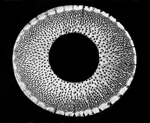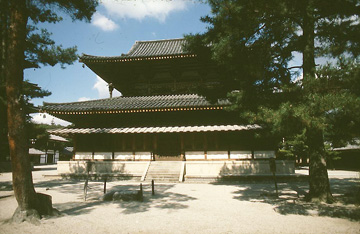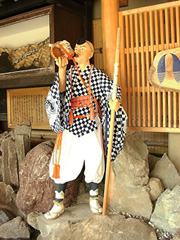
「修行尺八」歴史的証拠の研究 ホームページ
'Shugyō Shakuhachi' rekishi-teki shōko no kenkyū hōmupēji - zen-shakuhachi.dk
The "Ascetic Shakuhachi" Historical Evidence Research Web Pages
Introduction & Guide to the Documentation & Critical Study of Ascetic, Non-Dualistic Shakuhachi Culture, East & West:
Historical Chronology, Philology, Etymology, Vocabulary, Terminology, Concepts, Ideology, Iconology & Practices
By Torsten Mukuteki Olafsson •
トーステン
無穴笛
オーラフソン •
デンマーク • Denmark
 Shakuhachi-playing bodhisattva
|
ChronologyJAPAN 1 • 600-1233
JAPAN A.D. 600-1233 - THE AGE of the 'GAGAKU' SHAKUHACHI
|

Hōryū-ji Kondō, Nara - late 7th century - photo: T.O. 1977


Small sculpture of a bodhisattva playing a shakuhachi look-alike.
Discovered in 2009 during a restoration of the canopy overhanging the Shaka Triad being housed in the Hōryū-ji Kondō.
Source - now broken link: Yatō Osamu's komusō shakuhachi website

5+1 hole "Gagaku shakuhachi" owned by the Hōryū Temple in Nara
in The Gallery of Hōryū-ji Treasures, Tokyo National Museum. Precise date unclear.
Photo from the Tumblr gallery "Sally Away From Home".
Source: https://sallyawayfromhome.tumblr.com/post/168497873724/tokyo-national-museum-what-a-treasure-house-of

Hōryū-ji Kondō, Nara - late 7th century - photo: T.O. 1977
行者 - GYŌJA
山伏 - YAMABUSHI

Statue of En no Gyōja (alt. En no Ozunu), born in 634
Alleged founder of the 'Shugendō', an ascetic religious tradition combining elements of Chinese Taoism, Japanese Shintō,
esoteric Buddhism: Shingon 'Mikkyō' and Tendai,
as well as traditional Japanese shamanism.
A treasure of the Shugendō temple Ōminesan-ji, Yoshino District,
Wakayama Pref., founded by En no Gyōja. Maker and date unknown.

Yamabushi - modern statue at the entrance of the Hotel Yaotome
in Tsukuoka City, Yamagata Pref. Artist anonymous
雅楽尺八 - GAGAKU SHAKUHACHI
8th CENTURY:

Shōsōin Imperial Treasury, Tōdai-ji, Nara - early 8th century


Gagaku Shakuhachi, Shōsōin Imperial Treasury, Tōdai-ji, Nara
Early 8th century
唱名 - SHŌMYŌ
Mid 9th CENTURY / 13th CENTURY:
An anecdote about ENNIN, posthum. Jikaku Taishi, 793/794-866, playing a 'shakuhachi'
Go to the entry "1212" a little down below on this very same web page to read more.
Early 11th CENTURY:
" - - - Here in the excitement of the coming fête were assembled several young nobles, in addition to Genji himself.
Some practised dancing, others music, the sound of which echoed everywhere around. A large hichiriki and a shakuhachi were blown with the utmost vigor.
Even large drums were rolled upon a balcony and beaten with a will. - - - "
Murasaki Shikibu in 'Genji Monogatari', c. 1000-1020. Chapt. VI:
"Saffron Flower". Trsl. by Suematsu Kenchō, 1977.
LATE 12th CENTURY MYTH:
The ZEN MONK KAKUA 覺阿 PLAYING a FLUTE ???
禪
の
笛 - ZEN no FUE
Important note: This anecdote is apocryphal! That event most certainly never took place.
Go to the 1322 entry on this web page to read more
1212:
古事談 - KOJIDAN
"Tales of Ancient Matters"
A 13th century orally transmitted story known as 'setsuwa',
説話
An anecdote about ENNIN, posthum. Jikaku Taishi, 793/794-866,
supposedly having played a 'shakuhachi'
Important note: This anecdote is apocryphal. The "event" certainly never took place, so to speak!
唱名 - SHŌMYŌ
音聲不足令座給之間、
以尺八引聲ノ阿彌陀經ヲ令吹傳給ヌ、
「成就如是 功徳莊嚴」
ト云所ヲ, エ吹セ給ハザリケレバ、
常行堂ノ辰巳ノ松扉ニテ、
吹アツカハセ給タリケルニ、
空中ニ有音告云、
「ヤノ音ヲ加ヨ」云云、
自之如是ヤト云音ハ加也。
"At times when Ennin could not hear clearly, he used a shakuhachi in order to chant the Amida Sūtra.
If he did not manage to chant the passage '... an ideal environment so that whatever one lays eyes upon will bring about awakening',*
he would usually place himself by the 'Dragon and Serpent' pine wood doors of the temple hall, and when he had stopped blowing,
there was a voice in the middle of the empty sky proclaiming, 'Raise the ya note', and so forth. Consequently, the ya note had to be raised."
Reported in the 'Kojidan', 1212, by Minamoto no Akikane,
1160-1215. Trsl. by Torsten Olafsson. Source: Koji ruien.
This anecdote is quite certainly apocryphal.
Do note that Ennin was a Tendai monk, not a Zen monk.
Rather than actually "performing" the Amida Sutra on a shakuhachi,
Ennin would have employed the instrument mainly for intonation.
This anecdote is also reported in the Taigenshō of 1512.
* The unabridged sentence in the Amida Sūtra, par. 3, reads as follows:
舍利弗.極樂國土. 成就如是.功徳莊嚴。
"Shariputra, this land of Ultimate Bliss is an ideal environment so that
whatever one lays eyes upon will bring about awakening."
Translation: Jodo Shu Research Institute, 2003.
Link: Jodo Shu Research Institute

Shōsōin Imperial Treasury, Tōdai-ji, Nara - early 8th century


Gagaku Shakuhachi, Shōsōin Imperial Treasury, Tōdai-ji, Nara
Early 8th century

